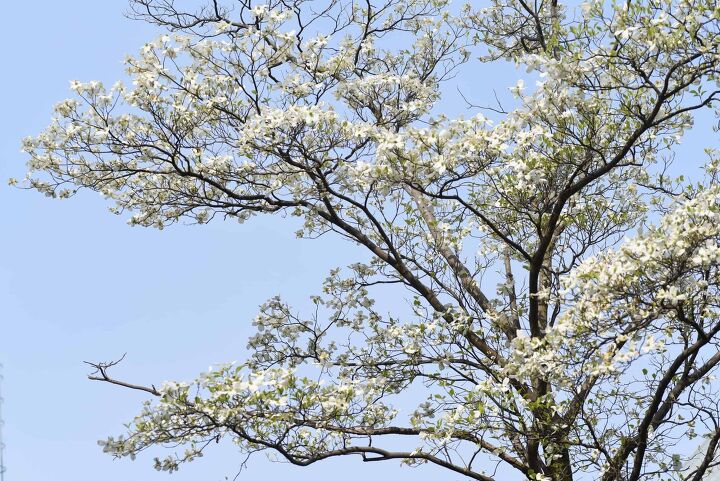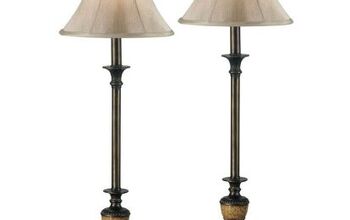17 Types Of Dogwood Trees (with Photos)

Dogwoods, from the genus Cornus, consist of a large group of flowering trees and shrubs. These plants are wildly popular because they provide interest year-round – with blooms early in the spring, berries in the summer, and stunning fall colors.
Some dogwood species even feature colorful stems, providing winter appeal to your landscape. This, paired with an average height of 20 feet, dogwoods can make an impressive addition to your garden.
The wood is often used in carving and other types of woodworking. With species native to North America, Europe, and Asia, in addition to numerous cultivars, you’ll have no issue finding a dogwood that best suits your purposes.
Dogwoods are commonly used as both flowering shrubs and trees in a landscape. The 15 types of Dogwood trees include:
- Flowering Dogwood
- Common Dogwood
- Mountain Dogwood
- Kousa Dogwood
- Gray Dogwood
- Cornelian Dogwood
- Canadian Bunchberry
- Stiff Dogwood
- Pagoda Dogwood
- Rough Leaf Dogwood
- Red Twig Dogwood
- Giant Dogwood
- Siberian Dogwood
- Himalayan Dogwood
- Brown Dogwood
- Red Osier Dogwood
- Cornus Glabrata Dogwood
- Walter’s Dogwood
- Silky Dogwood
Though, you are not limited to just these options. As one of the most common types of trees with a range of cultivars, each having distinct characteristics, there are numerous dogwoods to choose from.
We’ve gathered a list of 15 different types of dogwood trees and shrubs to help determine which is best for your garden.
15 Types of Dogwoods
There are approximately 17 dogwood varieties that are native to North America. Though, not all of them are popularly grown.
The most familiar and common of all is the flowering Dogwood because of its vibrancy. Continue reading for our complete list of the most popular types of dogwoods to inspire your garden planning.
1. Flowering Dogwood (Cornus Florida)
When many people imagine dogwoods, this is often the variety that comes to mind. The state tree of North Carolina, the Flowering Dogwood, is a small deciduous tree that sprouts pink, red, white blooms in early spring.
Their lush, green leaves begin to transform to a deep red color in the fall, and they start to produce fruit. Finally, the branches will feature small, attractive buds on their tips in winter.
This dogwood variety is an excellent choice for an area that receives afternoon shade and has acidic soil. They can grow to reach about 20 feet tall with a 12-inch wide trunk.
The flowering Dogwood, along with the Pacific dogwood, is prone to dogwood anthracnose. Though, this condition can be controlled by trimming off the affected branches.
2. Common Dogwood (Cornus sanguinea)
Also known as the European Dogwood and the Bloodtwig Dogwood, the common Dogwood is native to Europe and Western Asia. It is considered an upright deciduous shrub that features multiple stems. The plant is characterized by its elliptical to oval-shaped leaves and dull white blooms that sprout in late spring.
In August, the flowers transform into toxic blue-black berries. As a member of the Swida subspecies, the fruit that the common Dogwood produces should not be consumed by humans.
The common Dogwood’s fall leaves are typically a lovely red-purple hue. Young versions of this plant may also sport appealing red stems, but this usually fades to a dull green when the plant matures.
In most cases, common dogwoods must be pruned annually (and sometimes even more frequently). Be sure to keep this type of Dogwood in check; otherwise, it will spread fast.
3. Mountain Dogwood (Cornus nuttallii)
The mountain dogwood, or Pacific dogwood, is a moderately-sized deciduous tree with excellent tolerance for dry, drought conditions and shady locations. Many consider it to be the western version of the Flowering Dogwood.
Though with this type, the white blooms are much larger, and the fall foliage is a red, orange, or yellow color. The small berries to the mountain dogwood produce are either a bright red or orange.
Similar to flowering Dogwood, the mountain dogwood is very susceptible to dogwood anthracnose disease. Before you plant this type of plant, make sure to check your local regulations, as it may be discouraged.
You should also clear fallen leaves from around the trunk since the plant can get fungus. This type of Dogwood tends to grow slightly taller than the flowering Dogwood – approximately 82 feet.
4. Kousa Dogwood (Cornus kousa)
Also known as Japanese Dogwood, Korean Dogwood, or Chinese Dogwood, the Kousa dogwood is a small deciduous tree or shrub with multiple stems. Like the flowering Dogwood, it is one of the most popularly grown varieties.
They are grown primarily for ornamental purposes due to their showy blooms and colors. In springtime, the Kousa dogwood produces an abundance of yellow-green flowers and pinkish-red fruit in summer. Its fall foliage ranges from purple to red.
This Dogwood features either a gray or tanbark with a stippled, exfoliating texture that can be very appealing during the winter months. To enhance the appearance of the bark, lower branches should be trimmed away frequently.
5. Gray Dogwood (Cornus racemosa)
Often referred to as northern swamp dogwood, the gray Dogwood is a deciduous shrub native to the eastern parts of North America, including Maine, New Hampshire, Vermont, and Canada.
It earned its name from the gray hue of its leaves, although they typically feature other colors. This shrub forms thickets as the rhizomes spread underground.
In late spring, the plant produces white flowers, leading to white fruit in the summer. The berries are edible to birds but should not be consumed by humans.
This type of Dogwood has dark-green, lance-shaped leaves which transform to a purplish-red color in the fall. Each year, the gray Dogwood will have a fresh, new orange-brown bark. As it ages, the bark fades to a gray hue.
6. Cornelian Cherry (Cornus mas)
The cornelian cherry, or European cornel, is a large dogwood shrub or small tree that is one of the earliest woody plants to sprout flowers each season. In fact, the blooms show up in very early spring, even before the leaves have sprouted.
The plant has yellow flowers with oval foliage that is approximately four inches in length. Fruit can be harvested from this Dogwood once it has ripened and dropped to the ground.
This type of Dogwood is commonly found in parks and various residential areas, and it works great as a shade tree or for hedging. Ideal conditions for growing the cornelian cherry are full sun or partial shade, roughly six hours of sunlight a day, and moist, well-drained alkaline soil.
Unlike many of the other dogwoods mentioned thus far, the fruit that the cornelian cherry produces is edible. It is often used as an ingredient in sauces, jams, liquor, and even pickles. Unfortunately, the cornelian cherry’s fall foliage is not particularly showy.
7. Canadian Bunchberry (Cornus canadensis)
The Canadian bunchberry, often known simply as bunchberry or dwarf cornel, is considered a herbaceous subshrub of this group. It is a part of the subgenera Chamaepericlymenum, grows very low to the ground, and spreads by rhizomes.
This plant features dark green foliage with distinct veins. It produces white flowers in spring, which give way to bright red berries in late summer. The fruits of the Canadian bunchberry are edible for humans.
The plant’s fall foliage ranges in hue from red to purple. Although it is wildly different from most other dogwoods, there are still some similarities. If you’re in search of Dogwood that isn’t going to take up much space in your garden, the Canadian bunchberry is an excellent choice.
Native to Greenland, northeastern Asia, and North America, this plant grows best in partial shade and can reach a height between four and six inches.
8. Stiff Dogwood (Cornus foemina)
Also referred to as swamp dogwood, the stiff Dogwood is a large dogwood shrub or a small tree. The fruit that this type of Dogwood produces is a vibrant shade of blue. This plant also features attractive red twigs, which turn gray with age.
In spring, its small white flowers form in clusters known as cymes, which are known for their unpleasant smell. Though, the plant’s fall foliage is an appealing red or purple color.
The stiff Dogwood grows best in full sun to partial shade and can reach a total height of between 15 and 25 feet. It is native to the eastern and southeastern United States.
You’ll often find this plant growing in marshes, swamps, streambanks, and various upland locations. Though it prefers a moist climate, the stiff Dogwood can adapt to drier conditions.
9. Pagoda Dogwood (Cornus alternifolia)
Also known as alternate-leaf Dogwood, this common name for the Pagoda dogwood can help to identify it. This plant is one of the few dogwoods that feature foliage that is arranged alternately rather than in opposing positions on the stems. Its leaves form in clusters, and the cream-colored blooms thoroughly cover the plant’s branches.
The pagoda dogwood is typically a multi-stemmed deciduous shrub, although, with proper pruning, it can take on the form of a small tree. However, since the trunks of this type of Dogwood only reach about six inches in diameter and the branches grow horizontally, it tends to function more as a shrub.
The branches grow low on the plant and in layers, leaving only about a foot or two uncovered. Also, the crown is flat, reminiscent of a pagoda – hence the name.
10. Rough Leaf Dogwood (Cornus drummondii)
The rough leaf dogwood gets its name because of the coarse hairs found on the foliage. This is another type of Dogwood that does particularly well in shadier areas, though you can enjoy more blooms and berries if you decide to plant it in a location that receives full direct sunlight. It can be left as a multi-stemmed shrub or trained and pruned to take the form of a small tree.
The rough leaf dogwood produces flat-topped clusters of cream-colored flowers in the spring. Hard, white berries start to sprout in the summer, and the fall foliage is a purplish-red color.
Although uncommon in the wild, it is typically found along the Mississippi River and around many forest borders. The plant generally does best in moist conditions but can also have excellent tolerance for drier conditions once established.
11. Red Twig Dogwood (Cornus sericea)
Also known as the red osier dogwood, the red twig dogwood is a moderately-sized shrub that will visibly be in your landscape with its stems that start turning red at the end of the summer. Over time, the branches become a bright red, and by wintertime, the plant provides lovely contrast against a bare or snowy backdrop. These stems will become green again the following spring.
Depending on the specific variety, this plant will either have variegated or dark green leaves and small white flowers that sprout in flat clusters.
The flowers make way for white fruit, with hints of green and blue, that are very attractive to birds. Whereas the fall leaves feature typically have traces of gold or rose.
However, most gardeners find the foliage of red twig dogwoods less appealing in fall. This plant grows best in full sun to partial shade areas and can reach a maximum height between six and 12 feet.
12. Giant Dogwood (Cornus controversy)
Commonly referred to as the wedding cake tree, giant dogwoods are native to the Himalayas and various parts of Asia. It is a deciduous dogwood tree that proliferates and can reach an impressive 50 feet tall – hence the “giant” distinction.
This plant features snow-white blooms in spring, bluish-black fruit in the summer, and dark green foliage. In the fall, the foliage transforms to a purple-red hue.
The giant Dogwood grows best in the sun to partial shade and moist, well-drained soil. In hot climates, some afternoon shade is appreciated.
This Dogwood is a very showy variety, which offers year-round visual interest. Although the individual blooms are small, a giant dogwood in full bloom is magnificent. Due to their size, they are most often used in parks or organized landscaping designs.
13. Siberian Dogwood (Cornus alba)
The Siberian Dogwood is also known as red-barked and white Dogwood. It isn’t considered a tree but rather a surculose shrub. Though, when pruned correctly, it can serve as a small tree.
While the Siberian Dogwood may not have the showiest blooms, it does add some nice color to the landscape. It is known for its dark green foliage in the summer, red stems in the winter, and bluish-white berries.
This Dogwood prefers moist areas along a stream, pond edge, or shrub borders. It grows best in full sun to partial shade, approximately six hours of sunlight a day.
Although the plant favors moist, well-drained soil, it can adapt to many other soil conditions and tolerate wet conditions for more extended periods than many varieties.
14. Himalayan Dogwood (Cornus capitata)
Commonly referred to as evergreen dogwood, Bethams’ cornel, and Himalayan strawberry tree, the Himalayan Dogwood is native to woodland areas throughout Asia and parts of Australia. It is an evergreen, ornamental flowering tree that produces white flowers in the summer.
As summer gets hotter, the flowers will transform into pinkish-red fruits that will mature by fall. These fruits grow in clusters, characterized by their round shape and bumpy texture – similar to a strawberry.
The Himalayan Dogwood’s fruit can be eaten raw or cooked, used in pies, made into jams, and so much more. Their flavor ranges from bitter to sweet and is known for having a taste that is somewhat similar to an over-ripe banana.
15. Brown Dogwood (cornus glabrata)
Native to California and Oregon, the brown Dogwood is also known as western cornel or smooth Dogwood. It is a large deciduous shrub or a thicket-forming bush, with exceptionally limber branches that extend to the ground.
The bark of this plant may be a reddish, purple, or brown color, which offers interest in the winter when the leaves have all dropped. Its bright green leaves turn red in fall, and fuzzy-white flowers are found in springtime, giving way to bluish-white fruits.
The brown Dogwood will grow up to four feet in poor conditions and approximately ten feet in moist, shaded areas. This type of Dogwood is generally found near water, typically right on the bank of a water source, and it will be less thirsty in your garden by performing regular deep watering.
16. Walter’s Dogwood (cornus walteri)
Walter Dogwood is a medium-sized deciduous tree with a height and breadth of 30 to 40 feet.
In June, small white flowers set in two to three-inch diameter cymes join the two to five-inch long dark green leaves. The blossoms are followed by the development of little black fruits that attract birds and other creatures.
Walter Dogwood is recognized for its alligator-like bark on older specimens even more than Flowering Dogwood. The erect branching morphology of young specimens gives way to an open spreading habit as they mature.
Although they have not been studied for street tree usage in the United States, the branches are likely to droop less than most other Dogwoods, making it a suitable option for street tree use. Definitely a good patio tree that provides immediate shade.
17. Silky Dogwood (cornus amomum)
The Silky Dogwood is a large to medium-sized deciduous shrub that can reach a height of 6 to 12 feet. The shrub has multiple stems, is open, and has a rounded shape.
Clusters of creamy white blooms appear in the spring, followed by blue drupes that ripen in the late summer. Silky hairs cover the leaves and twigs. The dark brown pith of 1- to 2-year-old stems and dark-reddish twigs distinguish this plant.
The Silky Dogwood is endemic to the United States’ central and eastern regions and sections of Canada. It prefers swampy areas, wetlands, and areas near streams and ponds.
About Dogwoods
Cornus, the genus that Dogwoods belong to, is comprised of approximately 60 woody plant species of the family Cornaceae.
The majority of dogwoods are deciduous trees or shrubs. Although, there are some herbaceous perennial subshrubs, which are fast-growing and typically die back in the winter to ground level, growing back from buds found at the base of the plant.
Identifying Dogwoods
Dogwoods can be identified by their smooth-edged leaves, with veins that are parallel to the margins (edges). They are also known for their opposite branching, which also helps to identify them. Though, some dogwood species feature leaves that alternate on the stem instead.
Because of its showy nature, the Flowering Dogwood is the most commonly planted variety. Its flowers feature large bracts, a trait that other species of dogwoods may or may not have.
Dogwood Fruit
After pollination, dogwoods create a type of fruit called a drupe. In most cases, they are edible and can be used in cooking, though some dogwoods produce mildly toxic fruit to humans.
If you plan on consuming the fruit of your dogwood tree, make sure that you verify that the species is nontoxic first. Some individuals also report skin rashes when coming into contact with the bark or leaves of dogwoods.
What Colors do Dogwood Trees Come In?
White is the most prevalent hue for dogwood blossoms, but this varies per species. Monrovia describes the aurora dogwood (Cornus x “Rutban”) as having creamy white blossoms with a silky feel.
In the spring, their petals overlap and might obscure the green foliage. The pink Japanese Dogwood (Cornus kousa “Satomi”) yields exquisite pink blossoms.
The fall colors of the Dogwood are well-known for their beauty. Before the leaves change, however, numerous dogwood species show distinctive and lovely foliage.
The “Summer Gold” dogwood (Cornus kousa “Summer Gold”) has bright green leaves with golden edges that turn pink in the fall before turning fiery red. In the early spring, this lovely plant blooms with white flowers.
What to Plant Under Dogwood Trees
To avoid competing for moisture and soil nutrients, plants that respect the root growth needs of dogwoods are shallow-rooted. Use plants that require no more than 4 inches of soil depth in close proximity to the protective mulch circle.
There are far too many ground-cover plants that are hardy in the same zones as dogwoods to list. Look for types that are advertised as having a moderate growth rate rather than a high growth rate.
Ground covers that spread via stolons or rhizomes, or growth stems close to or just beneath the soil, as well as kinds that generate new plants at the end of leaf nodules, can spread without putting a strain on dogwood roots.
Some examples include but are not limited to:
- Creeping varieties of sedum
- Creeping Myrtle
- Mondo grass
- Periwinkle
- Bugleweed
What Causes Dogwood Trees to Die?
There are several things that kill Dogwood that you need to be on the lookout for. It’s not just improper drainage or care. There is some fungus you need to watch out for as well as insects:
- Dogwood Anthracnose: Leaf spots, stem cankers, and shoot death are all symptoms of dogwood anthracnose. If infected trees are not correctly cared for, they may succumb. This disease is not to be confused with anthracnose of the spot.
- Spot Anthracnose: Anthracnose typically affects flower bracts first, although it can also affect leaves, new shoots, and fruit.
- Septoria Leaf Spot: This sickness appears near the end of the summer. Stressed or weakened trees are more vulnerable than trees growing in natural settings or in good health. When damp circumstances persist, and humidity levels are high, Septoria leaf spot becomes more of a concern.
- Botrytis Petal Blight: Botrytis Botrytis cinerea is the fungus that causes petal blight. Foliage, green shoots, and petals are all affected by this fungus. The disease is most commonly seen in damp spring weather, frequently following a winter injury.
- Trunk Canker: The fungus Phytophthora cactorum causes basal trunk canker, which is a severe concern for urban dogwoods and is usually linked with low, poorly-drained locations.
- Dogwood Borer: The dogwood borer is a frequent insect problem on established dogwoods. The borer’s larvae enter the tree through cracks in the bark and feed on the tree’s cambium layer.
Related Guide

Jessica considers herself a home improvement and design enthusiast. She grew up surrounded by constant home improvement projects and owes most of what she knows to helping her dad renovate her childhood home. Being a Los Angeles resident, Jessica spends a lot of her time looking for her next DIY project and sharing her love for home design.
More by Jessica Stone

















![10 Best Electric Pressure Washers – [2022 Reviews & Guide]](https://cdn-fastly.upgradedhome.com/media/2023/07/31/9070600/10-best-electric-pressure-washers-2022-reviews-guide.jpg?size=350x220)













